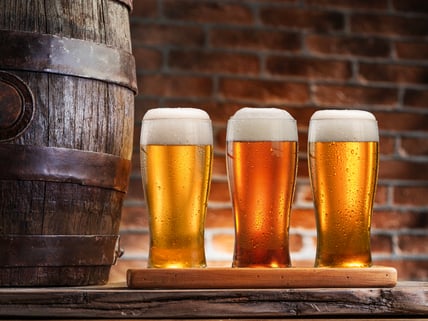
With operations around the globe, beer brewing is as popular and diverse as ever. In the U.S. alone, almost 10,000 craft breweries help shape the industry, from tiny microbreweries and lively brewpubs to community-focused taproom breweries and larger regional craft operations. Each brings its own unique flair to the art of brewing, offering a rich variety of flavors, styles, and experiences that reflect the creativity and passion of the people behind the pints.
History
For most of human history, beer was considered a health tonic, and was especially recommended for new mothers who were nursing. In part, this was because most sources of water were suspect, often containing pollutants and pathogens that could cause disease and death, such as the cholera-causing bacterium vibrio cholerae. Beer, which is brewed by boiling, filtering, and infusing with hops (which have strong antiseptic properties), is by contrast pathogen-free. In much of the world, including major European and American cities, it was actually safer to drink beer than the local water supply until well into the 20th century.
In addition, since for much of human history the average person faced regular and prolonged periods of insufficient food supply, the calorie-rich profile of a hearty beer served as an important dietary supplement. The ancient Egyptians brewed their beverage from bread remains and served it unfiltered with hunks of old bread still in the solution. This they drank morning, noon, and night, as often for the calories as for the alcoholic lift it provided.
The alcoholic content of beer—which typically ranges from 3% to 8% alcohol by volume (ABV)—is, of course, the matter that has made beer suspect in the eyes of many ever since the rise of the temperance and Prohibition movements in the mid-19th century.
The Prohibition era (1920-1933) was a uniquely disruptive time for American breweries, but it also sparked significant innovation and adaptability. Products like “near beer”—a beverage that looked and tasted like beer but was less than 0.5% alcohol—and malt syrup, which could be used to ferment beer at home, took advantage of legal loopholes to continue consumption.
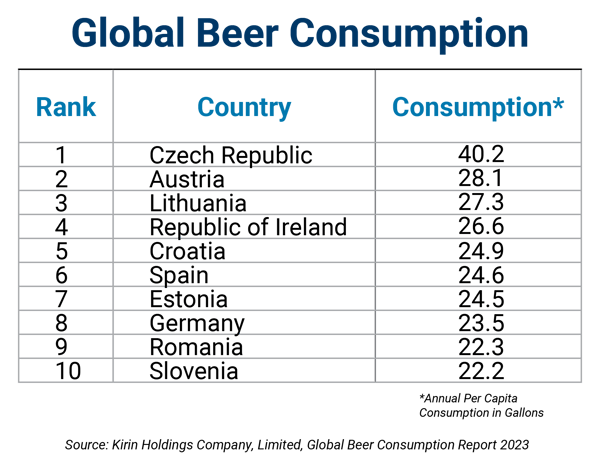
Beer Production
Beer is an alcoholic drink obtained by mixing ground-up malted barley with water, fermenting it with yeast, and flavoring it with hops. Sometimes, other grains can be used in addition to, or as a replacement for, the barley. The malted barley and yeast used to create fermentation are the basis of beer, but only part of the flavor equation. As one American brewery famously asserted, “it’s the water” used in making beer that has a strong influence on the final taste, and most especially, the hops.
But beer starts as a grain, and in 90% of all beers, that grain is barley, a notoriously hard seed that grows in clusters on a stalk of grass. Once cracked open, barley leaves an unpleasant aftertaste if eaten. Luckily for all, about 10,000 years ago someone figured out that if you soaked the seeds in warm water for two or three days and let them begin to germinate, then dried the seeds before they actually sprouted, the resulting half-germinated seeds—known as malt—were soft enough to be easily chewed or milled, and a great deal better-tasting to boot.
Malting barley is a science and an art unto itself, and from the earliest days of beer production brewers have relied upon maltsters—specialists who coax the seeds into germinating just enough before toasting them dry—to provide the fundamental ingredient in their craft. These days, malts are dried in a process known as kilning. Just like in coffee, the longer the time and higher the temperature used, the darker the malt and, ultimately, the darker and more full-bodied the beer will be. Malts destined for ales are generally kilned to a higher temperature, while lager-style beers usually rely on malts that are only mildly kilned.
Once the proper malt has been achieved, the toasted, half-germinated barley seeds are sent to the brewery. There, they are ground in a mill into a fine flour. This is the basic ingredient the brewer starts with, mixing the flour with warm water in a ratio of about three parts water to one part flour. This process is known as mashing, and takes place in a mash mixer, an enclosed vessel with a large mixing blade that can be adjusted to raise the temperature of the liquid contents to 149°F (65°C) or more, a point at which enzymes in the malt will begin converting the plant starches into fermentable sugars. After about an hour the temperature of the mixture is raised again, this time to a point that will stop most of the enzymatic activity.
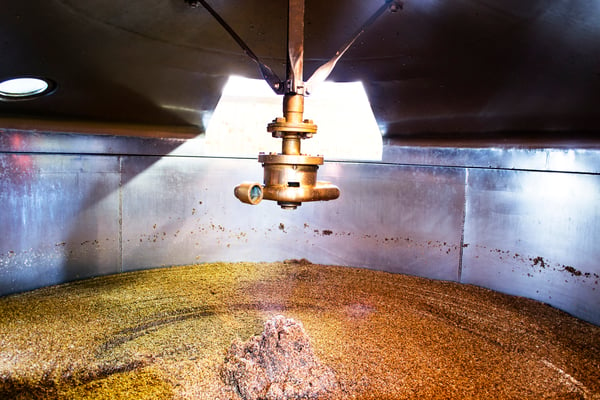 Malted barley in a mash tun; Photo courtesy of iStock, Mypurgatoryyears
Malted barley in a mash tun; Photo courtesy of iStock, Mypurgatoryyears
Now the mash is pumped into a large, shallow vessel called a lauter tun, in which the large particles and residual spent grains will settle off, and the sugary liquid portion of the mash, known as the wort (rhymes with Bert), is filtered out and run to the kettle. The remaining spent grains are rinsed with hot water to extract all additional fermentable material, and then eventually sold off as cattle feed.
Most people, if they have any mental image of a brewery, think of large, round-shouldered, gleaming copper kettles topped with a straight vent stack. In fact, most commercial breweries today use stainless steel kettles, though through traditional usage they are still called the “copper.” Here the wort is boiled, which both sterilizes the drink and drives out proteins that might make the beer cloudy. Boiling also eliminates any of the barley’s distinctive “grainy” aftertaste that might have survived the malting and mashing processes.
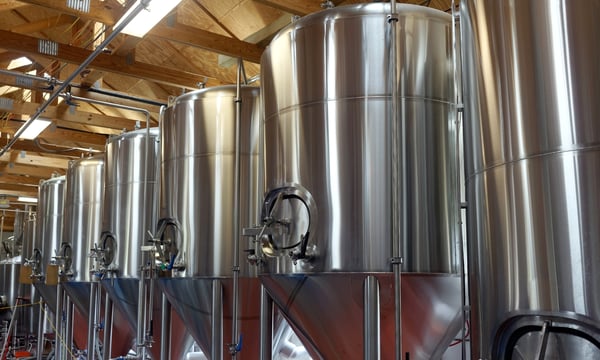 Brewery tanks; Photo courtesy of iStock, Joe_Potato
Brewery tanks; Photo courtesy of iStock, Joe_Potato
At some point during the boil, brewers add hops, which give beer its characteristic nose and bitterness, depending on how it is used. There are many ways hops flavoring can be introduced into the beer-making process, as dried cones, in a pulverized pellet form, and as essential oils and resin.
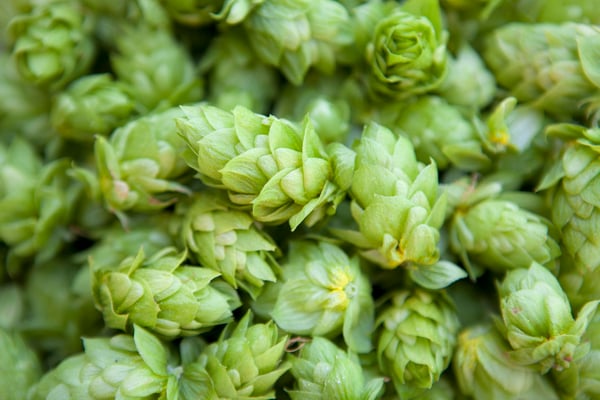 Hops are remarkable for the fact that they are grown only for beer, and have no other commercial agricultural purpose; Photo courtesy of iStock, LICreate
Hops are remarkable for the fact that they are grown only for beer, and have no other commercial agricultural purpose; Photo courtesy of iStock, LICreate
After the boil, the hopped wort is filtered, cooled, and transferred to fermenting tanks, where it is “pitched” with yeast. Beer is best fermented at low temperatures, in the range of 43°F-68°F (6°C-20°C), which is why, in centuries past, the best beers were made in the winter months.
Depending upon the kind of beer brewed, the fermentation process can last anywhere from several days to several weeks. When fermentation is complete and the correct alcohol content has been achieved, the yeast is harvested for re-use in the next fermentation, and the clarified beer is “conditioned” at about 1 degree below freezing for three days or more to encourage more proteins to drop out of the solution and prevent cloudiness. The final product is filtered, “enlivened” with additional carbonation if necessary, and packaged in kegs, cans, or bottles.
For more articles exploring the world and its industries, revisit our Boss Magazine issues.
Dixon Products for Beer Production
Dixon offers a full line of 304 and 316L stainless steel hygienic products for breweries.
Application
- Convey low viscosity fluids in the food, dairy, beverage, winery, and brewing markets
Size
- 1” outlet x 1-1/2” inlet
Features
- Uses a standard 4” tube clamp for easy removal and adjustment of the casing
- Robust single mechanical seal design with silicon carbide stationary seal-face and carbon rotary seal-face
- Sealed impeller provides optimal hygienic performance while the split shaft compression collar improves shaft concentricity, reduces vibration, and improves seal life
Specifications
- Operating temperature: 32°F to 212°F (0°C to 100°C)
- Viscosity range: 1-500 cP
- Nominal capacity: up to 75 GPM
Application
- Can be installed anywhere a traditional tri-clamp is in food, beverage, dairy, chemical, brewery, winery, and distillery markets
Sizes
- 1-1/2”, 2”, 3”, and 4”
Features
- Consistent, controlled compression of the gasket with every use
- Adjustable for both rubber and PTFE gasket styles
- Fast installation, no torquing tools required
Specifications
- Pressure rating:
- 1-1/2”: 500 PSI at 70°F (21°C)
- 2”: 450 PSI at 70°F (21°C)
- 3”: 350 PSI at 70°F (21°C)
- 4”: 300 PSI at 70°F (21°C)
Application
- Quarter-turn valve used to isolate and regulate flow of fluid in processing pipelines
Sizes
- 1”, 1-1/2”, 2”, 2-1/2”, 3”, and 4”
Features
- Compact design with 3” face-to-face dimensions for all sizes
- High-performance rubber seat design
- 360° trigger sprocket allows handle to be easily rotated to both sides of the valve without disassembly and reassembly of the valve handle
Specifications
- Operating temperature: 15°F to 200°F (-9°C to 93°C)
- Maximum pressure:
- 1/2” to 2”: 140 PSI
- 2-1/2” to 3”: 110 PSI
- 4”: 85 PSI
BV2-Series Encapsulated Sanitary Ball Valve
Application
- Used in sanitary processes for isolation or product flow control
Sizes
- 1/2” to 4”
Features
- Live-loaded stem packing
- Precision stainless steel balls reduce torque and friction losses while extending seat life
- Compact design for areas with tight space restrictions
- Fully encapsulated construction produces bubble tight seal
Specifications
- Operating temperature: -20°F to 450°F (-29°C to 232°C)
- Maximum pressure:
- 1/2” to 2”: 1000 PSI WOG
- 2-1/2” to 4”: 800 PSI WOG
SPR-Series Pressure Relief Valve: T Style and L Style
Application
- Used as a safety valve to bypass fluids if the discharge on a positive displacement pump is closed with the pump still running. The valve will open and bypass both liquids and gas.
Sizes
- 1-1/2” and 2”
Features
- Valve opens when the set pressure is reached to prevent excess pressure in piping or systems
- Valve body made from solid bar
- Low spare part cost
Specifications
- Maximum operating temperature: 266°F (130°C)
- Maximum sterilization temperature (20 minutes maximum): 300°F (148°C)
- Valve set pressure ranges:
- 10-49 PSI
- 50-99 PSI
- 100-300 PSI
Application
- Used in food processing, beverage, dairy, personal care, winery, brewery, pet product, and industrial markets to view fluids
Sizes
- 1/2” to 6”
Features
- Easy to assemble and disassemble
- Patented single clamp construction
Specifications
- 3A CIP certified
- Product contact metal components: Ra≤32
Application
- Ideal for cleaning all types of tanks and vessels
Sizes
- 3/4” and 1-1/2”
Features
- Stainless steel ball bearings
- Cleaning solution lubricates unit
- Mirror-like finish (O.D.)
- Spray pattern: 360°
Specification
- Available connections: clamp and NPT
Summary
From its early role as a nutritious and safer alternative to water to today’s diverse craft brewery scene, beer has evolved through centuries of innovation. The brewing process itself remains a carefully honed craft, refined over generations. Whether produced in small taprooms or large-scale facilities, every pint reflects the creativity, precision, and passion of the brewers behind it.
Dixon is delighted to help brewers tap into success one pint at a time. For more information, visit dixonvalve.com or call 877.963.4966.









